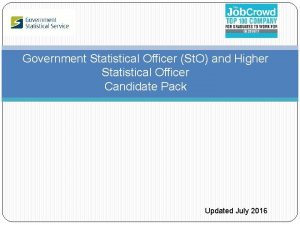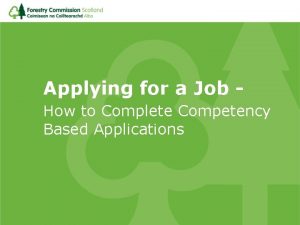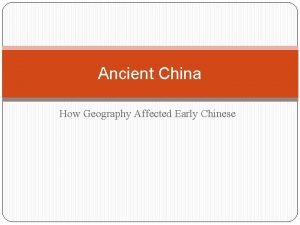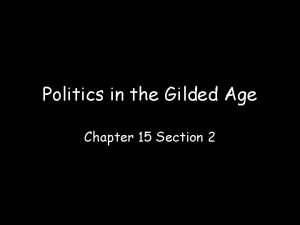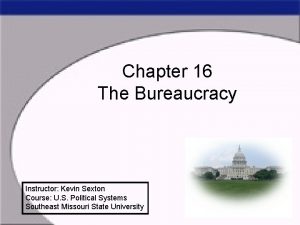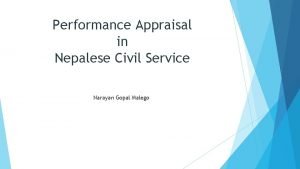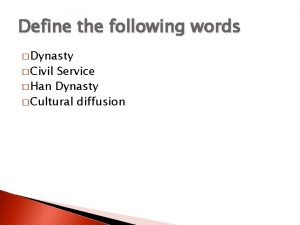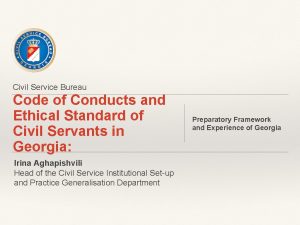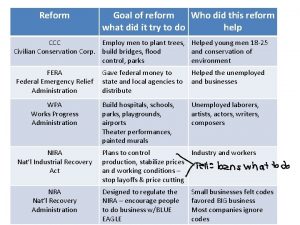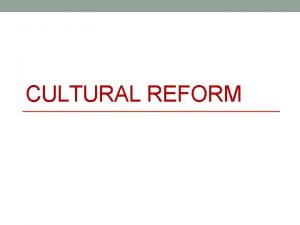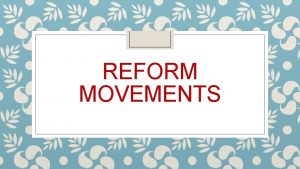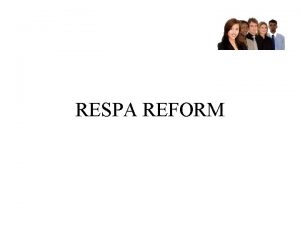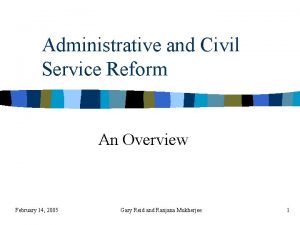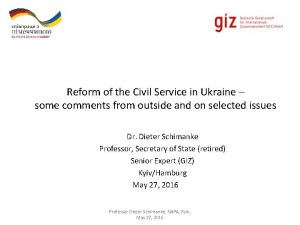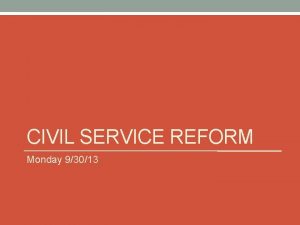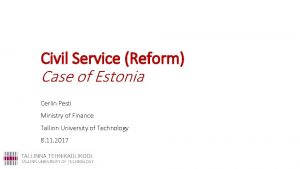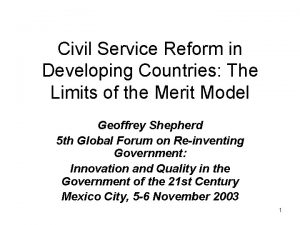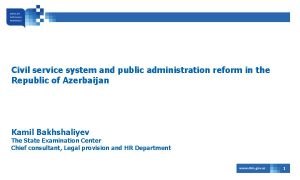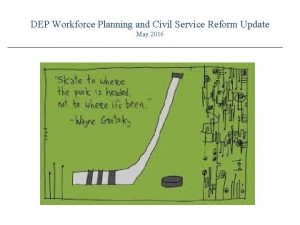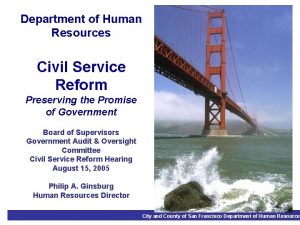A Review of the Civil Service Reform in






























































- Slides: 62

A Review of the Civil Service Reform in the Hong Kong SAR: Lessons for Asian Public Policy Makers Prof. Peter Fong M. U. P. , Ph. D (NYU) President Hong Kong Public Administration Association Email: fongpeter@netvigator. com Tel: (852) 9087 6336 1

Presentation outline 1. Background 2. Public sector reform in Hong Kong 3. Civil service reform in Hong Kong 4. Reform outcomes and achievements 5. Lessons for Asian public policy makers 6. Conclusion: Success & Core values of the Hong Kong civil service 2

1. Background Hong Kong: Overview (2017): Land Area - 1106 sq. km Population - 7. 4 million Life Expectancy - Male - 81 Life Expectancy - Female – 87 GDP – US $320 billion GDP Per capita - US $ 40, 000 Individual income tax rate - 15 percent Corporate tax rate - 16. 5 percent

Hong Kong Civil Service Profile (2017) ● ● Government administrative structure: 13 bureaux, 56 departments Civil Service: - Establishment: 174, 900 - Actual number: 167, 800 ● Civil service composition: - over 400 grades and 1, 000 ranks - Hong Kong Police Force – 33, 100 - More than 1, 360 directorate officers - More than 700 Administrative Officers ● Wastage rate: approximately 4. 7% per year 4

Historical and Political Situation Hong Kong is located on the southeastern coast of China at the western edge of the Pacific Rim. It has been a British colony since 1842 and was returned to China on July 1, 1997, according to the Sino—British Joint Declaration signed by both the British and Chinese governments in 1984. Under the principle of "one country two systems, " Hong Kong has become a Special Administrative Region (SAR) of China with a high degree of autonomy, and its existing capitalist economic system and way of life will remain unchanged for fifty years after 1997.

Problems in HK’s public sector: n The public sector’s grow needs to be checked. n The increasing size and complexity of Government activities has make it difficult to sustain a centrally controlled system. n The need to identify savings among existing programmes and to deploy them efficiently and appropriately to support future major infrastructural and social projects. 6

Problems in HK’s public sector: n Increasing public pressure for the government to be as competitive as its private sector, to improve services, to increase efficiency and to save costs in front of public criticisms. n Political pressure from the Legco with directly elected members on policy priority creating the need of flexibility. 7

2. Public Sector Reform in HK Development of Public Sector Reform 1989 1992 1994 1995 1998 1999 2000 2003 “Public Sector Reform” document published Establishment of the Efficiency Unit Governor’s Political Reform plan passed by Legco All Legco Members are Elected CE Launched the EPP Civil Service Reform plan launched. Voluntary Retirement scheme launched Second Voluntary Retirement scheme launched 8

The New Public Management n. A shift from issues of policy to issues of management, and an emphasis on quantifiable methods of performance appraisal and efficiency criteria. n A disaggregation of the public sector through breaking up traditional public bureaucratic structures into quasiautonomous corporatized units on a userpay basis. 9

The New Public Management n Attempts to increase competition in public service provision by surrogate markets, public tendering. n A strong emphasis on cost-cutting. n The introduction of private sector management practice that displays a measurable output targets, monetized incentives and managerial freedom. 10

Changing Roles of Government: n The provision of some public services Changes from government departments to public authorities or private organizations n Government becomes a supervisory or regulatory body 11

Public Sector Reform- Driving Forces for Change Public& Staff Aspirations Demand from Bureaux and Departments Political Pressure ================. Efficiency/speed. Openness. Service quality. Staff aspirations . Faster decision. More flexibility . Value for money. Openness. Accountability Public Sector Reform 12

HK’s Public Sector Reform Goals Control the Civil Service Establishment n Effective Small Government n Stream-line Government Structure n Controlling public expenditure 13

Public Sector Reform- Principles Serving the Community Managing for performance Living within our means Being accountable Developing a culture of service 14

Public Sector Reform- Objectives Serving the Community Performance pledges Devolution of authority Customeroriented Enhance efficiency and standards 15

Public Sector Reform- Programmes Policy Management Reform 1. Financial Management Reform 2. Human Resource management Reform 3. Institutional Reform 4. Operational Reform Means of Reform 1. Privatization 2. Corporatization 3. Marketization 4. Commercialization 16

Public Sector Reform- Framework PUBLIC SECTOR REFROM POLICY MANAGEMENT REFORM. Roles of Policy / Resource Bureaux. Programme Management Structures. Resource Allocation Process (A) FINANCIAL MANAGEMENT REFORM. Review of Finance Bureau. Financial Delegations (B) HUMAN RESOURCE MANAGEMENT REFORM. Review of CSB/Department. Delegation of CSRs (C) INSTITUTIONAL REFORM. Trading Funds. Contracting Out (D) OPERATIONAL REFORM. Performance Pledges. . Business Centres 17

Public Sector Reform- Target Areas Policy Management • Policy Bureaux • Programme management • Resource Allocation Exercise Financial Management • FB role • Financial delegation Institutional Operational • Trading Funds • Contracting out • Performance pledge • Business Centre Human Resources Management • Duty of CSB • Delegation under CSBs 18

Public Sector Reform in HK in Action: n n n n Performance Pledges (e. g. Inland Revenue Department, Fire Services Department) Trading Fund (e. g. Post Office, Land Registry) Corporatization (e. g. Hospital Authority, KCRC) Privatization (e. g. MTRC) Contracting out (e. g. Estate management, car parks, Police Station security) Re-inventing (e. g. Housing Authority, the reorganization of urban services) Customer satisfaction (e. g. Ombudsman) 19

3. HK Civil Service Reform (CSR) 20

Background n Difficult economic conditions after Asian financial crisis in 1998 , n Need to reduce the size and cut cost of civil service , n Incidents causing public criticisms of inefficiency in government, e. g. avian flu outbreak (1997) and chaotic opening of the new airport (1998) , n Need a high quality, efficient and trustworthy government and civil service. 21

Background l l l Started with a Proposal for consultation 8. 3. 1999 Vision: To ensure that Hong Kong continues to maintain a world-class civil service in keeping with the changing circumstances. New civil service system implemented in July 2000. 22

Reform Goals: To create : - An open, flexible, equitable & structured civil service framework - with more flexible means of entry & exit, - An enabling & motivating environment for civil servants, - A proactive accountable & responsible culture. 23

Objectives l To review and make changes to the remuneration and retirement package of civil servants to bring it more in line with market level and practices, l To encourage more efficient and cost-effective use of manpower resources & introduce measures towards this end, l To review and make improvements to the entry and system in the civil service so as to attract and retain talents and to remove under-performers effectively, l To introduce changes to the management and pay systems in the civil service which will motivate staff to do their best. 24

Implementation Principles 1. Change a midst stability 2. 3. 4. 5. 6. Step by step Comprehensive overview Wide consultation Practicable measures Reasonable & lawful 25

Methods to reduce the establishment 1. Process-re-engineering 2. Organizational review 3. Corporatization, privatization, contracting out 26

Main Areas of Reform Initiatives -Implemented in July 2000 1. Entry & Exit 2. Pay & Conditions of Service 3. Conduct & Discipline 4. Performance Management, Training & Development 27

Main Areas of Reform Initiatives 1. Entry & Exit n n n New entry system, terms of appointment, conditions of service for new recruits, Civil Service Provident Fund Scheme replaces the pension system, Launch the Voluntary Retirement Schemes and Management-Initiated Retirement Scheme, Introduce the Non-Civil Service Contract (NCSC) Staff, Decentralization of Staff Recruitment and Promotion. 28

Appointment System Existing System Envisaged System Retirement Supervisory Ranks Permanent and Pensionable Terms Exit Supervisory Ranks Permanent Terms Appointment Agreement Terms Promotion Appointment Basic Rank Probationary Exit Terms Satisfactory performance Recruitment Permanent and Pensionable Terms Exit Basic Rank Agreement Terms Recruitment 29

Entry & Exit a. CS New Entry System n Was: Appointed on permanent and pensionable terms with probationary period of 2 years. • Advantage: Stable and permanent CS, • Disadvantage: Discourage motivation of CS, Stifle exchange of talents with private sector. n From July 2000: Appointed initially on an probationary contract of three years, considered for further appointment on new permanent terms, subject to satisfactory performance (to allow more flexibility). n Reduce starting salary of CS after compared with private sector (Overall reduction: 6% to 31% of MPS). 30

Entry & Exit b. CS Provident Fund (CSPF) Scheme n Was: Pension Scheme – non-contributory, defined benefits. • Disadvantage: funded from future annual recurrent accounts. n After June 2000: the new CSPF Scheme. • Advantage: funded from current revenue, could be transferred to and from the private sector (MPF scheme in private sector). 31

Entry & Exit c. Voluntary Retirement (VR) Scheme n To achieve government’s aim to cut cost by reducing CS establishment (long term savings). • 1 st VR Scheme (Jul 2000) – 9800 retired, • 2 nd VR Scheme (Mar 2003) – 5300 retired. 32

Entry & Exit d. Management-initiated Retirement Scheme n Management tool to provide for retirement of directorate CS on pensionable and permanent terms to facilitate improvement in government organizations, n Allow injection of new blood by creating space at directorate ranks, n Maintain the quality of senior management. 33

Entry & Exit e. Non-Civil Service Contract (NCSC) Staff n Department Heads can employ staff on short term contracts, n Can devise their own employment package (no more favorable than CS of similar rank), n Advantage: Greater flexibility of employing staff, suitable for short term projects, n Disadvantage: low morale of contract staff against CS with much better salary and fringe benefits. 34

Entry & Exit f. Decentralization of Staff Recruitment and Promotion Process from Central to Departments n Advantage: Easy to appoint and terminate staff employment n Disadvantage: Cronyism and abuse, encourage shoe-shining culture 35

Main Areas of Reform Initiatives 2. Pay & Conditions of Service n Compare the entry pay between CS and private sector, revise the starting salary and carry out periodic starting salary survey, n Set up a Task Force to conduct comprehensive review of the CS pay policy and system, n Introduce new fringe benefits package, n Control government expenditure, review various CS allowances to achieve savings. 36

Pay and Fringe Benefits Existing Mechanism Envisaged Direction Pay Trend Survey mechanism Modify and improve the existing pay review mechanism to suit a performance-based pay system Salary levels reviewed regularly More frequent reviews to ensure broad comparability with the private sector pay levels Mainly promotion to recognise performance levels Salaries and promotion to recognise performance levels A range of fringe benefits Review all fringe benefits with reference to private sector practices 37

Pay & Conditions of Service n 11 pay scales of CS (Directorate Level, Master Pay Scale, General Disciplined Services, Police Pay Scale, Model Scale 1, etc. ) • Was: CS would progress upward on the scale through annual increment until reaching the maximum point of scale. • Now: Annual pay trend survey of salary in private sector. • (Review found CS’s salary and fringe benefits significantly outstripped private sector. • CS staff association’s objection: Survey ignored important factors such as skill and working condition. ) 38

Main Areas of Reform Initiatives 3. Conduct & Discipline n Streamline existing disciplinary procedures, set up independent Secretariat on CS Discipline to handle disciplinary cases. 39

Disciplinary Procedures Investigating Panel Adjudication Standing Secretariat Department/ Disciplinary Authority Public Service Commission Separate Review Mechanism Disciplinary Case Investigation/ Collection of Evidence Recommendation Award of/ Punishment Independent Advice Processing of Appeals 40

Conduct & Discipline n Disciplinary mechanism was reviewed and modified in early 2000, n Objective: Efficient and effective mechanism to punish CS misconduct (dismissal, suspension, compulsory retirement) and maintain deterrent, n The independent Secretariat on Civil Service Discipline was set up to centrally process formal disciplinary cases, streamlining the procedures, n Voluminous civil service regulations were consolidated into a summary form for ease of access. 41

Conduct & Discipline n Safeguard of CS Conduct and Discipline • Independent Commission Against Corruption (ICAC) – maintain standard of integrity in the public service. • Office of the Ombudsman – issue guidelines on ethical behavior for CS, promote honesty, integrity, professionalism, courtesy, loyalty and dedication. • Public Service Commission – advise on penalties to be applied on CS misconduct and offence, ensure consistency in disciplinary procedures. • Secretariat on Civil Service Discipline – process all disciplinary cases (but more often devolved to departments for minor infractions). 42

Main Areas of Reform Initiatives 4. Performance Management, Training & Development n Tighten rules on award of increments, n Stop and defer increments for officers with substandard work performance, n Training and development programmes to support implementation of the CS reform initiatives (Cyber Learning Plus website provides e-learning materials in systematic way to facilitate continuous self learning). 43

Performance Management, Training and Development Departmental Mission & Objectives Training & Development Career Development Exit Arrangements Provident fund system Resignation, retirement Redundancy Management-initiated exit Appointment Performance Management Pay & Conditions of Service Performance appraisal Supervision and guidance Code of conduct Performance-based pay system Fringe benefits in line with private sector Disciplinary action 44

Development of Performance Management in Civil Service n n n 1999 Civil Service Reform 2000 Review on Civil Service Performance Management 2003 Review on handling persistent sub-standard performers 2005 Review on managing cases of misconduct and under-performance in the civil service 2009 Civil Service Code 2009 Civil Service Outstanding Service Award Scheme 45

Performance Management System n. Introduced by Chief Executive Tung Chee Hwa n 1997 Policy Address - “Managing for results, by results” n 2004 Policy Address -“Maintaining a responsive and accountable government” Government must deliver the best possible services for public money 46

Overall Management Framework At Policy Level – Strategic n Outlining the Big Picture & Targets: what are we trying to achieve in our community? n Elements: n Chief Executive’s Policy Address n Policy Agenda booklet n Policy Briefings conducted by the Directors of Bureaux n 47

At Departmental Level Tactical & Operational n. How to achieve our goals? n. Are the goals done in a timely, quality and cost effective manner? Elements n. Vision and Mission n. Work Programmes n. Performance Pledges 48

“Performance Management Guide” Issued by CSB in 2000 Feature of a good performance management : – Open, fair and objective – Competency–based • core competency and functional competency – A continuous process • performance planning • continuous coaching and development • interim review • performance appraisal 49

Performance Management in CSR Granting of salary increments n–Only if the performance at work has been satisfactory during the appraisal period n–Stoppage and deferment of increments Improvement to the performance management system n–Putting in place assessment panels n–Target-based assessment and core competencies assessment n–Performance Management Guide 50

Handling persistent sub-standard performers Streamlined and revised procedure n–Start preparatory promptly n–Advice of an independent panel is to be sought n–Sub-standard performers are to be given appropriate counseling and assistance for improvement n–An overall “unsatisfactory” performance rating for 12 months - Retirement in the public interest n–Would constitute adequate grounds for taking action n–CSB follow through a normal case within 3 months 51

Civil Service Outstanding Service Award Scheme Objectives: nrecognize the efforts of departments npromote a customer-focused culture ninspire other departments and civil servants to emulate the best practices of award-winning departments and teams ncontinuous improvement in the delivery of public services 52

Professional Training and Personal Development Civil Service Training and Development Institute(CSTDI) - Launching enhanced Cyber Learning Centre and website to provide more e-learning materials in a more systematic way in April 2005. - Aim: facilitate civil servants’ continuous self -learning in anywhere & anytime. n 53

4. Reform outcomes and achievements Civil Service Reform: Achievements l Reduced civil service establishment from 198, 000 in early 2000 to 158, 000 in 2012, l Reduced starting salaries by 3% to 31% and fringe benefits for new recruits to keep in line with private sector trend, l Replaced pensions schemes for new recruits by Civil Service Provident Fund. 54

Civil Service Reform Achievements l l l Streamlined procedures and shortened time taken to deal with misbehaving or under-performing civil servants, Enhanced the operation of staff motivation and commendation schemes, Increased training and development opportunities and launched the Cyber Learning Centre Plus website. 55

New Human Resource Management - Change From “ Administration of rules ” To “ Management of staff ” - Implement HRM? Through: . Managing People Better . Delegation of Authority. Simplification of Rules & Procedures 56

5. Lessons for Asian public policy makers a. Before the reform, wide consultation with stakeholders including civil servants, staff unions, legislators and the public are needed. b. Meet public expectations on the quality of public services. c. Need legitimacy, accountability, probity and efficiency. d. Join the global bandwagon trend of NPM. 57

e. Political & managerial challenges after the Asian financial crisis and post-change of sovereignty. f. Changing outdated HRM rules and procedures for better governance. g. Enhance good performance and effectiveness of policies. h. Administrative reform to restructure and redefine institutional relationship. 58

6. Conclusion: Success & Core values of the Hong Kong civil service Ø political neutrality Ø professionalism Ø impartiality Ø administrative Ø honesty accountability and integrity Ø commitment to rule of law 59

International financial centres – New York, London, Hong Kong

Key Success Factors for Hong Kong 1. The rule of law 2. Clean government 3. Checks and balances 4. Freedom

Key Success Factors for Hong Kong 5. Political support by the Mainland’s central government 6. Efficient civil service to provide business support for investors 7. Good transport and communication infrastructure 8. Safe and low crime rate 9. Link with the fast growing Mainland market 10. Low personal and corporate tax rates
 Civil rights and civil liberties webquest
Civil rights and civil liberties webquest Civil war jeopardy review game
Civil war jeopardy review game Daniel gerson oecd
Daniel gerson oecd Gss competency framework
Gss competency framework Heo dwp jobs
Heo dwp jobs Civil service competency examples
Civil service competency examples Civil service of ancient han
Civil service of ancient han Pendleton civil service act
Pendleton civil service act Cfcd civil service
Cfcd civil service Dan sexton civil service
Dan sexton civil service The pool talent management
The pool talent management Civil service performance appraisal examples
Civil service performance appraisal examples Define han dynasty
Define han dynasty Civil service fast stream competencies
Civil service fast stream competencies Cssc bristol
Cssc bristol Civil service seeing the big picture example
Civil service seeing the big picture example Bristol civil service sports club
Bristol civil service sports club Civil service modernised terms and conditions
Civil service modernised terms and conditions Executive officer dwp
Executive officer dwp Finance business partner civil service
Finance business partner civil service Civil service bureau georgia
Civil service bureau georgia Hát kết hợp bộ gõ cơ thể
Hát kết hợp bộ gõ cơ thể Bổ thể
Bổ thể Tỉ lệ cơ thể trẻ em
Tỉ lệ cơ thể trẻ em Gấu đi như thế nào
Gấu đi như thế nào Thang điểm glasgow
Thang điểm glasgow Hát lên người ơi alleluia
Hát lên người ơi alleluia Môn thể thao bắt đầu bằng từ chạy
Môn thể thao bắt đầu bằng từ chạy Thế nào là hệ số cao nhất
Thế nào là hệ số cao nhất Các châu lục và đại dương trên thế giới
Các châu lục và đại dương trên thế giới Công thức tính thế năng
Công thức tính thế năng Trời xanh đây là của chúng ta thể thơ
Trời xanh đây là của chúng ta thể thơ Cách giải mật thư tọa độ
Cách giải mật thư tọa độ Làm thế nào để 102-1=99
Làm thế nào để 102-1=99 độ dài liên kết
độ dài liên kết Các châu lục và đại dương trên thế giới
Các châu lục và đại dương trên thế giới Thể thơ truyền thống
Thể thơ truyền thống Quá trình desamine hóa có thể tạo ra
Quá trình desamine hóa có thể tạo ra Một số thể thơ truyền thống
Một số thể thơ truyền thống Cái miệng nó xinh thế
Cái miệng nó xinh thế Vẽ hình chiếu vuông góc của vật thể sau
Vẽ hình chiếu vuông góc của vật thể sau Thế nào là sự mỏi cơ
Thế nào là sự mỏi cơ đặc điểm cơ thể của người tối cổ
đặc điểm cơ thể của người tối cổ Thế nào là giọng cùng tên
Thế nào là giọng cùng tên Vẽ hình chiếu đứng bằng cạnh của vật thể
Vẽ hình chiếu đứng bằng cạnh của vật thể Tia chieu sa te
Tia chieu sa te Thẻ vin
Thẻ vin đại từ thay thế
đại từ thay thế điện thế nghỉ
điện thế nghỉ Tư thế ngồi viết
Tư thế ngồi viết Diễn thế sinh thái là
Diễn thế sinh thái là Các loại đột biến cấu trúc nhiễm sắc thể
Các loại đột biến cấu trúc nhiễm sắc thể Thế nào là số nguyên tố
Thế nào là số nguyên tố Tư thế ngồi viết
Tư thế ngồi viết Lời thề hippocrates
Lời thề hippocrates Thiếu nhi thế giới liên hoan
Thiếu nhi thế giới liên hoan ưu thế lai là gì
ưu thế lai là gì Hươu thường đẻ mỗi lứa mấy con
Hươu thường đẻ mỗi lứa mấy con Khi nào hổ mẹ dạy hổ con săn mồi
Khi nào hổ mẹ dạy hổ con săn mồi Sơ đồ cơ thể người
Sơ đồ cơ thể người Từ ngữ thể hiện lòng nhân hậu
Từ ngữ thể hiện lòng nhân hậu Thế nào là mạng điện lắp đặt kiểu nổi
Thế nào là mạng điện lắp đặt kiểu nổi



